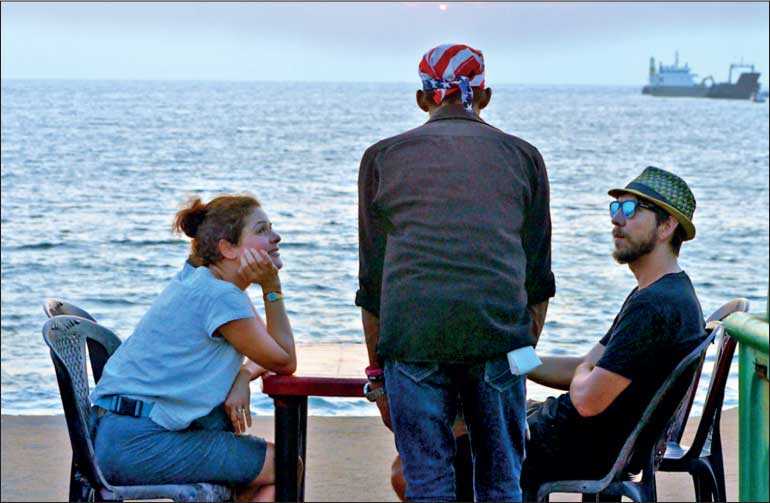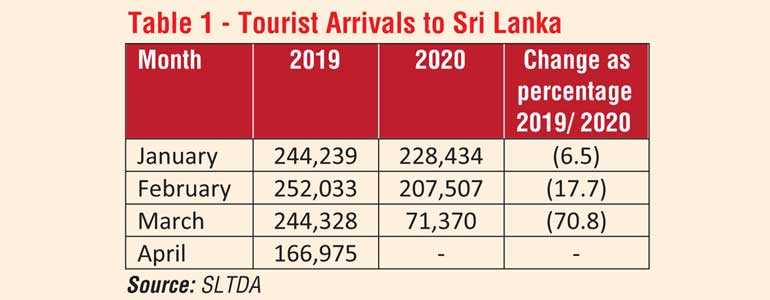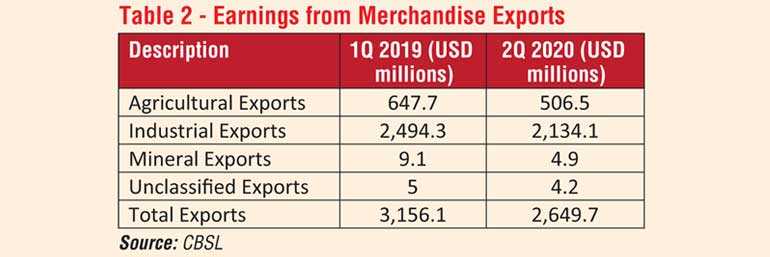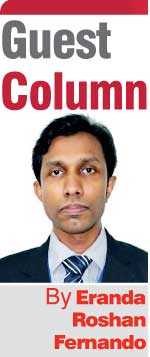Saturday Apr 19, 2025
Saturday Apr 19, 2025
Wednesday, 17 June 2020 00:10 - - {{hitsCtrl.values.hits}}

Although initiatives are underway to resume tourism from August onwards, it is likely to take a considerable time period to see the recovery – Pic by Shehan Gunasekara


Economic impact
The corona pandemic is sending ripples through the world economy. The total deaths reported exceed 400,000 as at second week of June 2020. The virus has affected both USA and EU, the major export markets for Sri Lanka which accounts for nearly 60% of the total exports from Sri Lanka. Fear of global economic recession looms large in the minds of people. Some of the economic implications on Sri Lanka are as follows:
1.Tourism sector
Undoubtedly, the worst affected sector of the economy. Towards the end of 2019, the tourism sector was on the recovery path after the Easter Sunday attack. However, due to outbreak of corona, tourist arrivals dropped by nearly 6% in Jan 2020 and 17% in Feb 2020 compared to the corresponding period in 2019. In March, the impact is more visible because the tourist arrivals decreased by 70% as indicated in Table 1.
According to the statistics compiled by Sri Lanka Tourism Development Authority (2019) nearly 400,000 people are employed in the tourism sector. The earnings from tourism have decreased by nearly 30% during the first quarter of 2020 compared to the corresponding period of 2019. During 1Q 2020, the earnings from tourism is $ 956 million where during the corresponding period of 2019 it is $ 1,396 million. Although initiatives are underway to resume tourism from August onwards, it is likely to take a considerable time period to see the
recovery.
2. Remittances
Sri Lanka is dependent on the remittances during the past few years to meet the trade deficit and ensure the stability of foreign exchange rate. Sri Lanka received nearly $ 7 billion during 2018 as remittances. Some of the migrant workers in Italy and Korea returned to Sri Lanka during the recent past due to the outbreak of COVID-19. The reduction of oil prices will also likely create a negative impact on remittance flow from Middle East where majority of Sri Lankan migrant workers are employed. Thus, we have to expect considerable reduction in the remittances during 2020.
3. Textile and garments
The leading export commodity of Sri Lanka which accounts for nearly 45% of the total merchandise exports is facing double jeopardy. The sector experienced difficulty in sourcing raw materials due to disrupted supply chains during the past few months and at the same time the major exports markets – USA and EU are down with the corona pandemic. The only consolation is that the garment sector has received orders for the production of personal protective equipment (PPEs).
4. Exports
USA and EU are the major export markets for Sri Lanka which account for nearly 60% of the total exports. However, as at now both USA and EU have been severely affected by corona. Iran, which is one of the major export markets for tea is also experiencing difficulties due to corona. Even at the end of the corona pandemic, it will take some time to regain the purchasing power of USA of EU which in turn affects the exports from Sri Lanka.
As illustrated in Table 2, during the 1Q 2020 the earnings from merchandise exports have decreased around 16% compared with the corresponding period of 2019. During the year 2019 also the merchandise export growth is less than 1%. 
5. Employment
During the fourth quarter of 2019, the unemployment rate was increased up to 5.1%. Due to COVID-19, we have to expect at least a short term increase in the unemployment especially among daily wage earners and self-employees. According to the survey conducted by Department of Labour (2020), some business entities have indicated, that they are experiencing difficulties to pay the salaries of employees. The report indicates that lay-off and termination strategies will lead to the increase of unemployment figures.
Post-COVID-19 economic revival
Sri Lanka has been experiencing trade deficit throughout past decades. According to the Central Bank (2020) some of the imported food items are as shown in Table 3.
According to Table 3, it is evident, Sri Lanka has spent more than $ 1 billion on agri-based product imports in 2019. Considering trade deficit and external debt repayment obligations of Sri Lanka, it is absolutely necessary to follow the expedited approach for the development of the agriculture sector during the post-COVID-19 period. The developments of the agriculture sector minimise the necessity of agri-product imports thus reduce the trade deficit.
Some SMEs have pointed out that they are experiencing various difficulties in providing collateral to secure the concessionary working capital loans which are offered at a concessionary rate. Addressing the issues experienced by SMEs in securing working capital loans and also increasing the allocated amount of Rs. 50 billion relief packages is important to support the entrepreneurs which in turn save the jobs of the people.
During the COVID-19 period there is a sudden surge in the e-commerce activities in Sri Lanka. Consumers around the world are compelled to purchase goods online during the past few weeks. Policymakers can focus on areas such as increasing cyber security, improvement of internet connectivity and incentivise SMEs to facilitate the growth of e-commerce in Sri Lanka.
(The writer is a postgraduate qualified economic policy researcher, and can be contacted via [email protected].)
Discover Kapruka, the leading online shopping platform in Sri Lanka, where you can conveniently send Gifts and Flowers to your loved ones for any event including Valentine ’s Day. Explore a wide range of popular Shopping Categories on Kapruka, including Toys, Groceries, Electronics, Birthday Cakes, Fruits, Chocolates, Flower Bouquets, Clothing, Watches, Lingerie, Gift Sets and Jewellery. Also if you’re interested in selling with Kapruka, Partner Central by Kapruka is the best solution to start with. Moreover, through Kapruka Global Shop, you can also enjoy the convenience of purchasing products from renowned platforms like Amazon and eBay and have them delivered to Sri Lanka.
Discover Kapruka, the leading online shopping platform in Sri Lanka, where you can conveniently send Gifts and Flowers to your loved ones for any event including Valentine ’s Day. Explore a wide range of popular Shopping Categories on Kapruka, including Toys, Groceries, Electronics, Birthday Cakes, Fruits, Chocolates, Flower Bouquets, Clothing, Watches, Lingerie, Gift Sets and Jewellery. Also if you’re interested in selling with Kapruka, Partner Central by Kapruka is the best solution to start with. Moreover, through Kapruka Global Shop, you can also enjoy the convenience of purchasing products from renowned platforms like Amazon and eBay and have them delivered to Sri Lanka.